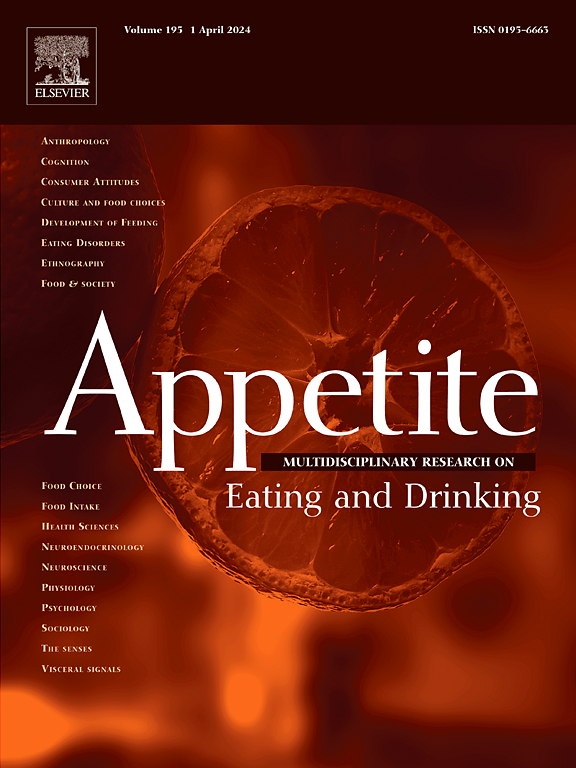Beyond the family's cooking frequency: The influence of cooking techniques on vegetable and fruit consumption among the U.S. population
IF 3.8
2区 医学
Q1 BEHAVIORAL SCIENCES
引用次数: 0
Abstract
Background
Despite the well-established health benefits of fruits and vegetables, U.S. consumption remains far below the WHO's recommended 400 g per day. Understanding how culinary techniques influence intake could elucidate strategies for improving dietary habits.
Objective
To explore whether the use of cooking techniques for fruits and vegetables is associated with increased consumption of these foods and the corresponding variation in total fiber intake among the U.S. population.
Methods
Data from the National Health and Nutrition Examination Survey (NHANES) 2009–2010, participants (n = 9754) were categorized into groups based on their self-reported cooking frequency. Cooking techniques were classified into types. The mean consumption of fruits and vegetables was segmented into quartiles. Cooking frequency was evaluated, and differences between groups were assessed using chi-square tests and mean comparison tests. The study also assessed the prevalence of cooking techniques for different food groups. Additionally, linear regression analyses were conducted to adjust the mean daily per capita consumption of fruits, vegetables, and dietary fiber, considering cooking frequency and other socioeconomic variables as predictors.
Results
The studied population's mean consumption of fruits and vegetables was 302.9 g, with half of this amount consisting of fruits. Individuals from households with frequent cooking practices (≥5x a week) consumed, on average, 48.2 g more fruits and vegetables daily than those from households with less frequent cooking (<5x a week). The use of diverse cooking techniques significantly improved vegetable intake, showing a fivefold increase in consumption among those employing multiple techniques. Moreover, frequent home cooking was associated with a 1.0-g increase in daily fiber intake.
Conclusion
Public policies aimed at improving fruit and vegetable intake among the U.S. population should consider, in addition to cooking frequency, the role of cooking techniques in influencing the consumption of these food groups.
超越家庭烹饪频率:烹饪技术对美国人口蔬菜和水果消费量的影响。
背景:尽管水果和蔬菜对健康的益处已得到证实,但美国的消费量仍远远低于世界卫生组织推荐的每天 400 克的标准。了解烹饪技术对摄入量的影响可以阐明改善饮食习惯的策略:目的:探讨水果和蔬菜烹饪技术的使用是否与这些食物消费量的增加以及美国人口总纤维摄入量的相应变化有关:方法:2009-2010年美国国家健康与营养调查(NHANES)的数据,根据参与者(人数=9754)自我报告的烹饪频率将其分为几组。烹饪技术分为不同类型。水果和蔬菜的平均消费量被分为四等分。对烹饪频率进行了评估,并使用卡方检验和均值比较检验对组间差异进行了评估。研究还评估了不同食物组的烹饪技术的普及率。此外,还进行了线性回归分析,以调整水果、蔬菜和膳食纤维的人均日消费量,并将烹饪频率和其他社会经济变量作为预测因素:研究人群的水果和蔬菜平均消费量为 302.9 克,其中一半为水果。经常烹饪(每周烹饪次数≥5 次)的家庭比不经常烹饪的家庭平均每天多摄入 48.2 克水果和蔬菜:旨在提高美国居民水果和蔬菜摄入量的公共政策,除了考虑烹饪频率外,还应考虑烹饪技术在影响这些食物种类的摄入量方面所起的作用。
本文章由计算机程序翻译,如有差异,请以英文原文为准。
求助全文
约1分钟内获得全文
求助全文
来源期刊

Appetite
医学-行为科学
CiteScore
9.10
自引率
11.10%
发文量
566
审稿时长
13.4 weeks
期刊介绍:
Appetite is an international research journal specializing in cultural, social, psychological, sensory and physiological influences on the selection and intake of foods and drinks. It covers normal and disordered eating and drinking and welcomes studies of both human and non-human animal behaviour toward food. Appetite publishes research reports, reviews and commentaries. Thematic special issues appear regularly. From time to time the journal carries abstracts from professional meetings. Submissions to Appetite are expected to be based primarily on observations directly related to the selection and intake of foods and drinks; papers that are primarily focused on topics such as nutrition or obesity will not be considered unless they specifically make a novel scientific contribution to the understanding of appetite in line with the journal's aims and scope.
 求助内容:
求助内容: 应助结果提醒方式:
应助结果提醒方式:


